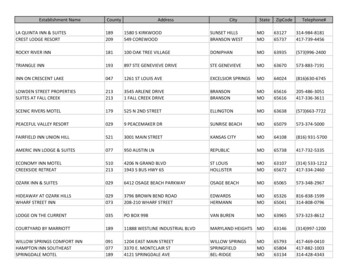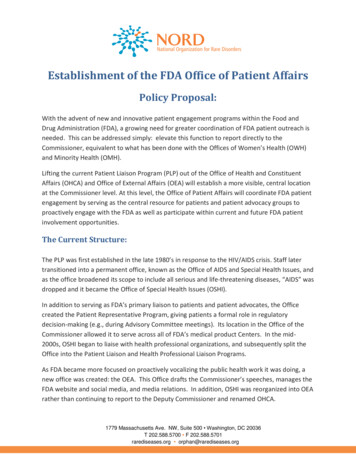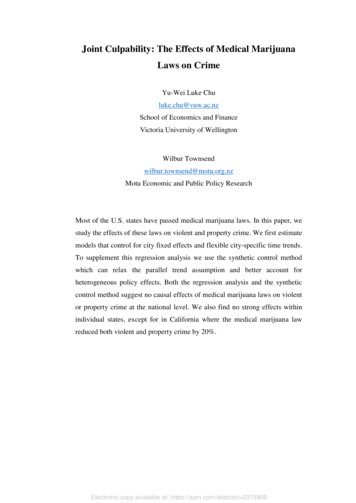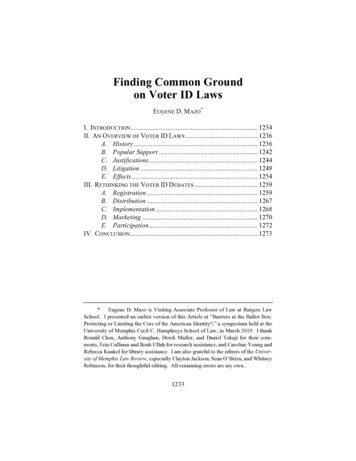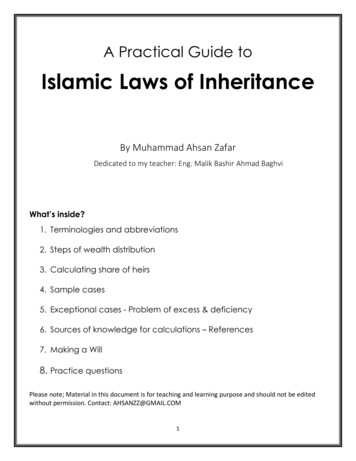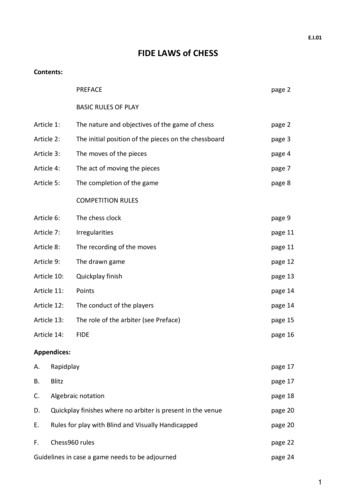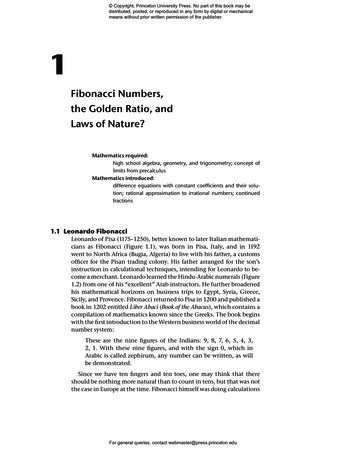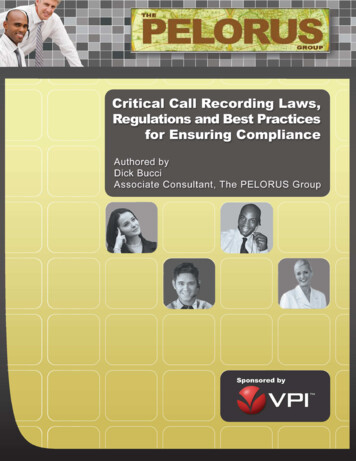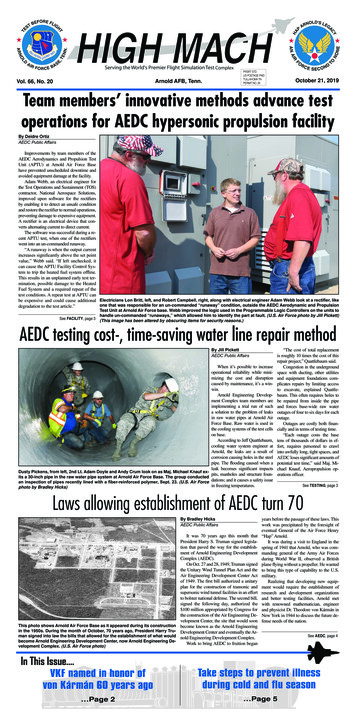
Transcription
PRSRT STDUS POSTAGE PAIDTULLAHOMA TNPERMIT NO. 29Arnold AFB, Tenn.Vol. 66, No. 20October 21, 2019Team members’ innovative methods advance testoperations for AEDC hypersonic propulsion facilityBy Deidre OrtizAEDC Public AffairsImprovements by team members of theAEDC Aerodynamics and Propulsion TestUnit (APTU) at Arnold Air Force Basehave prevented unscheduled downtime andavoided equipment damage at the facility.Adam Webb, an electrical engineer forthe Test Operations and Sustainment (TOS)contractor, National Aerospace Solutions,improved upon software for the rectifiersby enabling it to detect an unsafe conditionand restore the rectifier to normal operations,preventing damage to expensive equipment.A rectifier is an electrical device that converts alternating current to direct current.The software was successful during a recent APTU test, when one of the rectifierswent into an un-commanded runaway.“A runaway is when the output currentincreases significantly above the set pointvalue,” Webb said. “If left unchecked, itcan cause the APTU Facility Control System to trip the heated fuel system offline.This results in an unplanned early test termination, possible damage to the HeatedFuel System and a required repeat of thetest conditions. A repeat test at APTU canbe expensive and could cause additional Electricians Lon Britt, left, and Robert Campbell, right, along with electrical engineer Adam Webb look at a rectifier, likeone that was responsible for an un-commanded “runaway” condition, outside the AEDC Aerodynamic and Propulsiondegradation to the test article.”Test Unit at Arnold Air Force base. Webb improved the logic used in the Programmable Logic Controllers on the units tohandle un-commanded “runaways,” which allowed him to identify the part at fault. (U.S. Air Force photo by Jill Pickett)See FACILITY, page 3(This image has been altered by obscuring items for security reasons.)AEDC testing cost-, time-saving water line repair methodBy Jill PickettAEDC Public AffairsWhen it’s possible to increaseoperational reliability while minimizing the cost and disruptioncaused by maintenance, it’s a winwin.Arnold Engineering Development Complex team members areimplementing a trial run of sucha solution to the problem of leaksin raw water pipes at Arnold AirForce Base. Raw water is used inthe cooling systems of the test cellson base.According to Jeff Quattlebaum,cooling water system engineer atArnold, the leaks are a result ofcorrosion causing holes in the steelpipe. The flooding caused when aleak becomes significant impactsDusty Pickens, from left, 2nd Lt. Adam Doyle and Andy Crum look on as Maj. Michael Knauf expits, manholes and structure founits a 30-inch pipe in the raw water pipe system at Arnold Air Force Base. The group conductedan inspection of pipes recently lined with a fiber-reinforced polymer, Sept. 23. (U.S. Air Force dations; and it causes a safety issuein freezing temperatures.photo by Bradley Hicks)“The cost of total replacementis roughly 10 times the cost of thisrepair project,” Quattlebaum said.Congestion in the undergroundspace with ducting, other utilitiesand equipment foundations complicates repairs by limiting accessto excavate, explained Quattlebaum. This often requires holes tobe repaired from inside the pipeand forces base-wide raw wateroutages of four to six days for eachoutage.Outages are costly both financially and in terms of testing time.“Each outage costs the basetens of thousands of dollars in effort, requires personnel to crawlinto awfully long, tight spaces, andAEDC loses significant amounts ofpotential test time,” said Maj. Michael Knauf, Aeropropulsion operations officer.See TESTING, page 3Laws allowing establishment of AEDC turn 70By Bradley HicksAEDC Public AffairsThis photo shows Arnold Air Force Base as it appeared during its constructionin the 1950s. During the month of October, 70 years ago, President Harry Truman signed into law the bills that allowed for the establishment of what wouldbecome Arnold Engineering Development Center, now Arnold Engineering Development Complex. (U.S. Air Force photo)It was 70 years ago this month thatPresident Harry S. Truman signed legislation that paved the way for the establishment of Arnold Engineering DevelopmentComplex (AEDC).On Oct. 27 and 28, 1949, Truman signedthe Unitary Wind Tunnel Plan Act and theAir Engineering Development Center Actof 1949. The first bill authorized a unitaryplan for the construction of transonic andsupersonic wind tunnel facilities in an effortto bolster national defense. The second bill,signed the following day, authorized the 100 million appropriated by Congress forthe construction of the Air Engineering Development Center, the site that would soonbecome known as the Arnold EngineeringDevelopment Center and eventually the Arnold Engineering Development Complex.Work to bring AEDC to fruition beganyears before the passage of these laws. Thiswork was precipitated by the foresight ofeventual General of the Air Force Henry“Hap” Arnold.It was during a visit to England in thespring of 1941 that Arnold, who was commanding general of the Army Air Forcesduring World War II, observed a Britishplane flying without a propeller. He wantedto bring this type of capability to the U.S.military.Realizing that developing new equipment would require the establishment ofresearch and development organizationsand better testing facilities, Arnold metwith renowned mathematician, engineerand physicist Dr. Theodore von Kármán inNew York in 1944 to discuss the future defense needs of the nation.See AEDC, page 4VKF named in honor ofvon Kármán 60 years agoTake steps to prevent illnessduring cold and flu season Page 2 Page 5
2 October 21, 2019ArnoldAir ForceBaseCol. Jeffrey GeraghtyCommanderJason AustinChief,Public AffairsRichard TigheGeneral Manager,National AerospaceSolutionsHigh Mach Staff:Kathy Gattis,NAS Executive EditorJill PickettNAS EditorHigh Mach is published byLakeway Publishers, Inc. a private firm in no way connectedwith the U.S. Air Force, ArnoldAir Force Base, Arnold Engineering Development Complex(AEDC) or National AerospaceSolutions (NAS), under exclusive written contract with NASat Arnold AFB, Tenn., 37389.Everything advertised inthis publication will be madeavailable for purchase, useor patronage without regardto race, color, religion, sex,national origin, age, marital status, physical handicap, politicalaffiliation or any other nonmerit factor of the purchaser,user or patron.The High Mach office islocated at 100 Kindel Drive,Suite A236, Arnold AFB, Tenn.37389-1236. Editorial contentis edited and prepared by NAS.Deadline for copy is Wednesday at close of business oneweek before publication.This commercial enterprisenewspaper is an allowableNAS contractor publicationfor personnel at Arnold AFB.The content of High Machdoes not necessarily reflect theviews of the Air Force, ArnoldAFB, AEDC or NAS. The appearance of advertising in thispublication does not constituteendorsement of the productsor services advertised by theDepartment of Defense, theDepartment of the Air Force,Arnold AFB, AEDC, NAS orLakeway Publishers, Inc.For general informationabout High Mach, call (931)454-5655 or visit www.arnold.af.mil.Use High Mach to market your products andservices. Contact Joe at931-455-4545 or jmartin@tullahomanews.comCore Values Integrity first Service before self Excellence in allwe doVision“NAS delivers the bestaerospace testingcapabilities today and inthe future.”Values Ethics. We are uncompromising in ourintegrity, honesty, and fairness. Safety & Health. We are relentless inkeeping people safe from harm, andwe provide a safe and healthy workenvironment. Security. We are disciplined and vigilantin protecting sensitive AEDC informationand ensuring system integrity to supportnational security and our customers. Excellence. We thrive on challenge,accomplishment, and mission success. Quality. We are passionate about doingour work right the first time. People. We have a mission-focused,inclusive workforce who have a diverseskill set, are committed to success,demonstrate innovation and have a cando attitude. Culture. Our team is proud of our diversity, inclusiveness, and collaborative workenvironment. We are proud of what we doand how we do it. Relationships. We build positive, longterm business relationships through trust,respect, and collaboration. Innovation. We overcome challengesthrough creativity, perseverance, technology, and flexibility. We actively seek tocontinually improve. Sustainability. We plan and act for thelong term benefit of our communities andour environment.VKF named in honor of von Kármán 60 years agoBy Bradley HicksAEDC Public AffairsSixty years ago, a test facilityat Arnold Air Force Base was renamed in honor of the man whohelped provide the blueprint thatled to the construction of the nowArnold Engineering Development Complex headquartered atArnold AFB.During an Oct. 30, 1959, ceremony, the Gas Dynamics Facilitywas dedicated as the von KármánGas Dynamics Facility, a hypersonic wind tunnel testing facility,in honor of mathematician, physicist and engineer Dr. Theodorevon Kármán.The event marked the firsttime that the Air Force hadnamed a major facility after aliving person. Von Kármán addressed the crowd gathered forthe ceremony.“There is no doubt in mymind that this is the greatest honor that I have ever experienced,”von Kármán said. “But I wouldhave thought the Air Force wouldhave waited a few years until Ihad the occasion to look back atthis from beyond infinity. I thinkthat is really the tradition, thatthe scientist, if he gets somethingdedicated in his name, should already be dead. But I am glad theAir Force managed an exceptionand gave me the opportunity toaccept this honor.”Von Kármán, a native JewishHungarian, was born May 11,1881. His mathematical prowesswas evident from an early age.By the time he was 6 years old,von Kármán could reportedlymultiply six-digit numbers in hishead with the speed of a calculator. When he was 16, he wasawarded the Eotvos Prize as thefinest mathematics and sciencestudent in all of Hungary.Von Kármán began his careerstudying fluid mechanics at theGöttingen Mathematical Institutein Germany, but he became interested in aeronautics after attending an aerial demonstration. Herelocated to Aachen, Germany, topursue his interest in aerodynamics. In 1912, he accepted the position of director of the AachenAeronautical Institute.During World War I, von Kármán took on the role of directorof research of the Austro-Hungarian Aviation Corps. Also anAustrian lieutenant during thewar, von Kármán worked on helicopters, machine gun and propeller synchronization and fueltank penetration while getting anup-close look at advancements inaerial warfare.After the war, von Kármán resumed his position at the AachenAeronautical Institute and onceagain focused on aerodynamicsresearch.In the late 1920s, the California Institute of Technology,also known as Caltech, hired vonKármán to serve as a consultantfor a new wind tunnel. By 1930,Caltech had added von Kármánto their staff as full-time directorof the Guggenheim Aeronautical Laboratory of the CaliforniaInstitute of Technology. It wasthere that he made significantcontributions to fluid mechanics,turbulence theory, supersonicflight, mathematics in engineer-Dr. Theodore von Kármán speaks during the Oct. 30, 1959, ceremony to dedicate the Gas DynamicsFacility at Arnold Air Force Base in his honor. Von Kármán helped provide the blueprint that led tothe construction of Arnold Engineering Development Complex at Arnold AFB. Seated behind vonKármán is Gen. Bernard Schriever, then-commander of Air Force Systems. (U.S. Air Force photo)ing, aircraft structures and winderosion of soil.Von Kármán’s work caughtthe attention of Henry “Hap” Arnold, the man who would laterbecome General of the Air Force.The two had several meetings todiscuss the future of air research,and von Kármán began workingwith Arnold to advance the United States’ air force.In 1939, Arnold asked vonKármán to design a 20-footwind tunnel for Wright Field inOhio. Toward the end of WorldWar II, Arnold again soughtvon Kármán’s help. This time,Arnold asked him to establish ascientific advisory group to develop a blueprint for future airresearch.In spring 1945, von Kármánand a group of scientists traveled to Europe and questionedGerman engineers about theirprogress in aviation during thewar. The group also visited several facilities, including the Tyrolian Alps, where the world’smost powerful wind tunnel wasthen under construction.In a 1945 letter to Arnold,von Kármán recommended thecreation of new facilities thatcould help meet the objectiveof developing supersonic andpilotless aircraft.That December, the grouppresented its findings in a reportentitled Toward New Horizons.In it, they called for the creationof a research and developmentfacility that could be used forthe study and development ofjet propulsion, supersonic aircraft and ballistic missiles.“The Center for Supersonicand Pilotless Aircraft Development should be equipped withadequate wind tunnel facilities to attain speeds up to threetimes the velocity of sound,with large enough test sections to accommodate modelsof reasonable size, including jetpropulsion units, and one ultrasonic wind tunnel for exploration of the upper frontier of thesupersonic speed range,” thereport states. “Ample facilitiesfor the study of combustion andother characteristics of propulsion systems at very high altitudes should be provided.”The Gas Dynamics Facility at Arnold Air Force Base was dedicated in honor of Dr. Theodore von Kármán on Oct. 30, 1959. (U.S.Air Force photo)Construction on this facility, today known as Arnold Engineering Development Complex, would begin less thanfive years later.Then-Air Force Chief ofStaff Gen. Thomas White provided a message to then-AEDCCommander Maj. Gen. TroupMiller Jr. for the Oct. 30, 1959,ceremony.“There can be no doubt inanyone’s mind that our survival as an independent country in a free world may welldepend upon our technological preeminence and the extent of the support behind it,”White wrote. “The combinedvision and collaborative effortof General Arnold, the militaryman, and Dr. von Kármán, thedistinguished scientist, recognized this fact many years ago.Together, they did somethingabout it. For this, our countryshould be eternally grateful.“In naming the Gas Dynamics Facility in honor of Dr. vonKármán, the Air Force is dedicating a facility which alreadyhas proved of untold value inour national research and development programs, a facilitywhich has the capacity to growin importance and usefulness instep with technical advances asthey occur. This is true becauseone man’s intuitive and crystalclear thinking has opened thedoor to greater successes inthe future. That man is DoctorTheodore von Kármán.”Von Kármán would makefurther contributions to thefield of aerodynamics, including his involvement in thedevelopment of supersonicaircraft and intercontinentalballistic missiles, developedtheories and co-founded theNASA Jet Propulsion Laboratory in California. He was alsoa founder of the Aerojet Corporation.He also received approvalfrom the North Atlantic TreatyOrganization, more commonlyreferred to as NATO, to launchthe NATO Advisory Group forAeronautical Research andDevelopment. Von Kármánchaired that group until hisdeath in May 1963.Von Kármán was posthumously recognized as an Honorary AEDC Fellow in 2002.The VKF at Arnold is comprised of several wind tunnelsused to obtain large aerodynamic and aerothermodynamicdatabases to develop supersonic and hypersonic flightvehicles. Customers use thesefacilities to conduct testing forstatic stability, pressure loads,jet interaction, store separationand vehicle staging, heat transfer, inlet integration, materialsampling, thermal mapping,and dynamic stability, including forced and free oscillation.Smoking PolicyAction Line1. The following revised Arnold AFB smoking policy is effective immediately and applies to all individuals onArnold AFB.2. Traditional Tobacco products (e.g. cigars and cigarettes):a. Smoking is permitted solely in Designated Tobacco Areas (DTAs) identified by designated signage. If nosignage exists, smoking is not permitted in that area. It is the responsibility of all smokers to keep DTAsclean of cigarette butts.b. Tobacco use on the Arnold AFB Golf Course is permitted, but discouraged based on the health hazardsof tobacco use and secondhand smoke. No smoking is permitted within 50 feet of golf course buildingsexcept in the approved DTA.c. Smoking in government-owned/leased vehicles is strictly prohibited. Personnel are allowed to smoke in theirpersonal vehicles at any time; however, at no time will personnel discard cigarette butts outside their vehicle.d. For government employees, the fact that a person smokes has no bearing on the number of breaks theymay take. Breaks should be taken in accordance with the current supervisory and personnel policies thatafford all employees the same break opportunities consistent with good work practices and accomplishment of the mission.3. Smokeless Tobacco products (e.g. snuff and dip):Smokeless tobacco products are not to be restricted to DTAs. Smokeless tobacco use will be permitted in allworkplace areas (inside and out) subject to reasonable safety and sanitary conditions. Specifically, containersof tobacco waste product, including sealed containers, must not be left unattended or disposed of in trashreceptacles. Users of smokeless tobacco must flush tobacco waste down the toilet.4. Electronic Cigarettes (also known as “e-cigs”):Pursuant to Air Force Instruction (AFI) 40-102, Tobacco Free Living, e-cigs are considered to be equivalent totobacco products; however, e-cigs are not restricted to DTAs and are allowed to be used outdoors at a minimumdistance of 25 feet from building entry/egress points. (This policy is dated July 27, 2016)Col. Jeffrey GeraghtyAEDC CommanderTeam AEDC,I believe in free and open communicationswith our Team AEDC employees, and that’s whywe have the Action Line available. People canuse the Action Line to clear up rumors, ask questions, suggest ideas on improvements, entercomplaints or get other issues off their chests.The Action Line has been expanded to include an option for your ideas, comments, orsuggestions on the AcqDemo personnel system. Simply call the normal x6000 commander’saction line. You will then be prompted to selectoption 1 for the Commander’s Action Line or Option 2 for the AcqDemo line. They can access theAction Line via the AEDC intranet home pageand by calling 454-6000.Although the Action Line is always available,the best and fastest way to get things resolvedis by using your chain of command or by contacting the organization directly involved. I encourage everyone to go that route first, then ifthe situation isn’t made right, give us a chance.
October 21 2019 3FACILITY from page 1Webb explained that the software modifications also allowedhim to isolate the cause of the uncommanded runaway.“When the software detecteda runaway, it swapped controlmodes,” he said. “This enabled usto continue normal operations andprovided the run data we needed tobetter understand what was reallygoing on. With this new information we were able to determinethat a poorly-designed componentconnection by the manufacturer,along with high vibration duringtesting, was causing the issue. Wedeveloped a new connection method which eliminates the potentialfor this to occur in the future.”Sharon Rigney, APTU groupmanager for TOS at Arnold,commended Webb for his workimproving upon the rectifier software.“Innovative ideas and forwardthinking in anticipation of possible failure modes and problemsgreatly improves the performanceof our Instrumentation, Dataand Controls systems,” she said.“Adam is to be commended forhis proactive approach towardspossible failure modes and correction actions.”Efforts by Gareth Penfold,an
Oct 18, 2019 · baum. This often requires holes to be repaired from inside the pipe and forces base-wide raw water outages of four to six days for each outage. Outages are costly both finan-cially and in terms of testing time. “Each outage costs the base tens of thousands of dollars in ef-fort, requires
